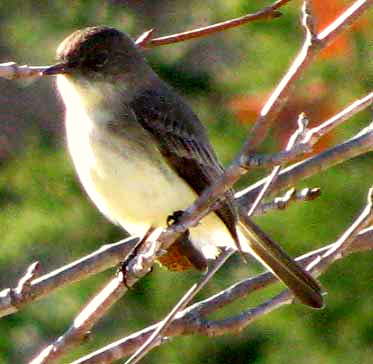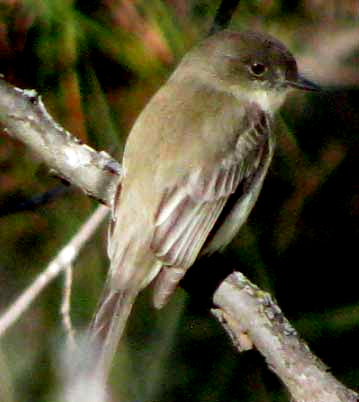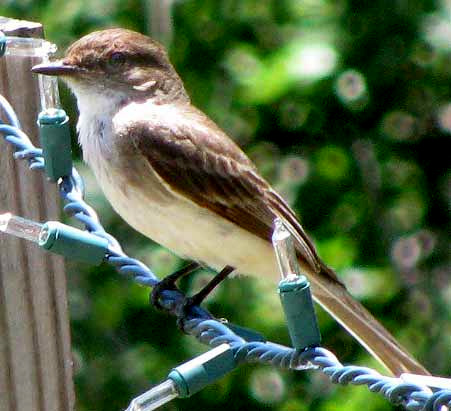Excerpts from Jim Conrad's
Naturalist Newsletter
from the January 13, 2013 Newsletter issued from the valley of the Dry Frio River in northern Uvalde County, southwestern Texas, on the southern border of the Edwards Plateau; elevation ~1750m (~5750 ft); N29.62°, W99.86°; USA
PHOEBE AT THE RIVER'S EDGE
On a sunny but chilly morning a small flycatcher worked along the gravelly edge of the little Dry Frio River behind the cabin. He'd perch awhile, then fly down onto the gravel or maybe zip out and catch something in midair, for on sunny days here we do still have insects buzzing about and ranging across the ground. Grasshoppers flutter from grass, spiderlings balloon through air, and all kinds of gnaty things fly about, so there are things here for a flycatcher to eat.
Usually flycatcher species are so similar to one another that they can be hard to distinguish. However, even with my poor vision I could whittle down the possibilities for this one, for he flipped his tail up and down with quick, jerky motions. In Mexico several overwintering flycatcher species wag their tails, but around here only the phoebes do it.

However, here in southwestern Texas we have three tail-wagging phoebe species: the Eastern; Black, and; Say's Phoebes. The latter two species are western birds, with us at the eastern fringes of their ranges, and we're at the western fringe of the Eastern Phoebe's range.
As soon as our bird's picture was on my laptop screen I could see that it wasn't the black-topped Black Phoebe, or the Say's with its rusty underparts, but rather the Eastern Phoebe, SAYORNIS PHOEBE, as you can confirm in the above picture. A back view of the same bird is shown below:

Besides being tail waggers, Eastern Phoebes also are recognized by their dark heads without eye rings and their solid black beaks. Beaks of similar-looking wood pewee species display pale lower mandibles.
In most of eastern and central North America Eastern Phoebes are to be seen only during their summer nesting season, retiring to the US southeastern states and much of Mexico during the winter.
During the summer it's always a treat, almost comical, to hear the Eastern Phoebe calling because his call is so unusual and funny sounding, especially coming from such a small, plain-looking bird. In a raspy, almost gruff voice he says, not sings, "fee-be, fee-be," again and again.
from the February 9, 2003 Newsletter issued from the woods south of Natchez, Mississippi, USA
PHOEBE EATS GROUND SKINK
So, I was walking along the woods and spotted a phoebe on a low branch jerking in an odd way. The binoculars instantly showed that the bird had in his beak a very squirmy Ground Skink, SCINCELLA LATERALIS, our most common species of lizard. When I garden, Ground Skinks constantly flush from the leaf mulch I stir up. They appear year round, except on the very coldest days. Since they breed from January to August and produce up to five clutches a season of one to seven eggs, they are pretty prolific. They eat insects and spiders, mostly.
Now, from tip of beak to tip of tail, a Phoebe is about 5.75 inch long (15 cm). Most Ground Skinks I see are about 3.5 inches long (10 cm). Therefore, one wonders how the gut of a 15 cm bird can accommodate a 10 cm skink. Moreover, this skink definitely didn't want to be swallowed. Three times I saw him escape from the phoebe's beak, but each time the bird dove and snapped him from mid-air as he fell, his beak rapidly clicking behind the falling quarry. Just imagine how that bird's brain must be wired to enable such fast response!
Again and again the phoebe repositioned the skink in his mouth, rather like a Robin might flip an earthworm around and around until it goes limber. However, this skink never stopped fighting so eventually the bird threw back his head, in went the skink's front end, and the bird swallowed... and gaped, and swallowed, and jerked his head, and swallowed, and gaped... for a couple of minutes... until the skink's tail vanished into the bird's gullet.
The phoebe then went through a series of jerks and bumps and grinds of the kind you might expect of a bird who had just swallowed something squirmy nearly as long as he was. I also was jerking, bumping and grinding, just thinking of what it must feel like.
But before long the bird flew to a low perch and began nonchalantly wiping his bill on a twig, and looking around as if he wanted a bug dessert.
from the June 9, 2013 Newsletter issued from the valley of the Dry Frio River in northern Uvalde County, southwestern Texas, on the southern border of the Edwards Plateau; elevation ~1750m (~5750 ft); N29.62°, W99.86°; USA
PHOEBE NEST
Below you can see a nest found this week perched atop a security lamp on the backyard porch of my friend Phred across the river:

It was easy to know which bird species the nest belonged to because as I approached the nest a pair of birds perched nearby began chipping and acting upset. You can see one of them below:

That's an Eastern Phoebe. Despite phoebes being here all winter, I was a little surprised to find these nesting on Phred's porch because distribution maps I've seen for the species indicate that they don't nest this far southwest. However, Michael Overton's "Birds of Uvalde County, Texas" checklist reports them as common here year round. We must be at the very most extreme southwestern point of their distribution. Say's Phoebes and Black Phoebes also occur here, which are western species, so that points to how remarkable our bird population is here.
Cornell Lab of Ornithology's Eastern Phoebe webpage says that only the female builds the nest, but she's often accompanied by the male, and that the nest is constructed of mud, moss, and leaves mixed with grass stems and animal hair. The nest on Phred's porch is made of lichen on a mud platform. Cornell continues by saying that nests may be situated on firm foundations, like ours, or they may adhere to a vertical wall using a surface irregularity. At first the female may need to hover in place as she forms a mud base to perch on. Nests can take 5-14 days to build and are about five inches across (13cm) when finished. The nest cup is 2.5 inches (6cm) across and two inches (5cm) deep.
from the June 16, 2013 Newsletter issued from the Frio Canyon Nature Education Center in northern Uvalde County, southwestern Texas, on the southern border of the Edwards Plateau; elevation ~1750m (~5750 ft); N29.62°, W99.86°; USA
COWBIRD EGG IN PHOEBE NEST

Last week we looked at a nest of a pair of Eastern Phoebes on my neighbor Phred's back porch. This week, wanting to see if eggs had been laid, I pressed a downward-pointing camera against the porch ceiling about three inches (8cm) above the nest and took the picture shown above.
Eggs of the Eastern Phoebe are about ¾ inch long (2cm) and normally are white, sometimes speckled with reddish brown. But they're not as speckled as the very speckled egg in the center. That center egg, which also lacks the other eggs more pointed end, is an egg of the Brown-head Cowbird. Cowbird eggs are described as having a ground color varying from an almost pure white to grayish white, or sometimes pale bluish or milky white, with specks and blotches varying from brown or tawny to reddish brown.
Nests of Eastern Phoebes are known to be particularly heavily parasitized by Brown-headed Cowbirds. The female cowbird spots another bird species, such as our phoebes, building a nest, then the cowbird lays a single egg -- rarely more -- in the "host nest." The female cowbird may remove or destroy one of the original nest eggs. Sometimes the parents in whose nest the cowbird has laid her egg recognize that there's a problem and remove the cowbird egg, or build a new nest over the old nest, or abandon the nest entirely. Usually, though, the adopted parents continue with their nesting as if nothing has happened. Cowbird eggs normally hatch before other eggs in the nest. The cowbird nestling typically is larger than the other nestlings and grows so much faster that sometimes the smaller nestlings are crowded from the nest. The cowbird nestling may so aggressively beg for food that other nestlings starve.
Cowbirds mostly inhabit forest edges. During most of songbird evolution, forests were extensive with relatively limited "edges," so cowbird nest parasitization wasn't a huge problem. However, nowadays forests are so fragmented into tiny parcels that nearly everything is "edges," and the effect of cowbirds is more pronounced than before.
Still, a good case can be made that various "cowbird control programs" are useless and ethically questionable. A good discussion of the issue is provided in a PDF document you can download from the American Birding Association after using a search engine on the title "Brown-headed Cowbird: Villain or Scapegoat?"
That document argues that the effects of cowbirds are negligible in comparison to habitat destruction. That's a point I heartily agree with.